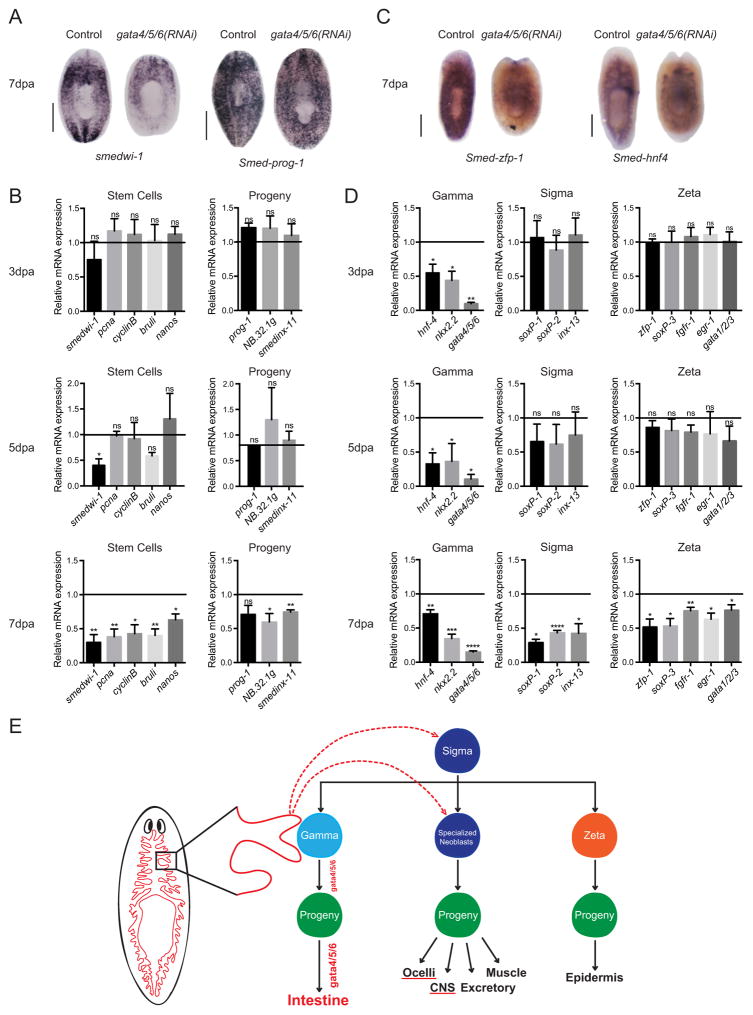Fig. 4.
Loss of Smed-gata4/5/6 rapidly eliminates the gamma sub-class of neoblasts and affects both the zeta-class and sigma-class. (A) Representative WISH for smedwi-1 and Smed-prog-1, markers for the stem cells and progeny, respectively. (n = 5) Scale bars: 500 μm. (B) Representative WISH for Smed-zfp-1 and Smed-hnf-4, markers for the zeta-class and gamma-class, respectively. (n = 5) Scale bars: 500 μm. (C) RT-qPCR analysis showing mRNA expression changes in stem cell and progeny marker transcripts of control and Smed-gata4/5/6(RNAi) animals. Bar graphs show fold change in expression relative to controls after normalization to GAPDH. Controls represented by horizontal line set at 1. Two-tailed unpaired Student’s t-test (****: p-value < 0.0001,***: p-value < 0.001, **: p-value > 0.01, *: p-value > 0.05, ns: not significant) values represent average and error bars s.e.m. Analysis for 3dpa and 7dpa regenerating trunks based on 3 biological replicates (n = 15), each replicate containing 5 animals pooled. Analysis for 5dpa regenerating trunks based on 2 biological replicates (n = 10), each replicate containing 5 animals pooled. (D) RT-qPCR analysis showing mRNA expression changes in gamma-class, zeta-class, and sigma-class marker transcripts following Smed-gata4/5/6 RNAi. Bar graphs show fold change in expression relative to controls after normalization to GAPDH. Controls represented by horizontal line set at 1. Two-tailed unpaired Student’s t-test (****: p-value < 0.0001, ***: p-value < 0.001, **: p-value > 0.01, *: p-value > 0.05, ns: not significant) values represent average and error bars s.e.m. Analysis for 3dpa and 7dpa regenerating trunks based on 3 biological replicates (n = 15), each replicate containing 5 animals pooled. Analysis for 5dpa regenerating trunks based on 2 biological replicates (n = 10), each replicate containing 5 animals pooled. (E) Model of Smed-gata4/5/6 action in S. mediterranea (based on van Wolfswinkel et al. (2014)). Gamma neoblasts are required for the development and maintenance of the intestine, and Smed-gata4/5/6, which is expressed at low levels in these neoblasts and higher levels in differentiated intestinal cells, is intrinsically essential for this process. The most likely mechanism to explain the late defects in other neoblast populations (e.g. sigma and zeta subtypes) and other differentiation lineages (e.g. ocelli and CNS) in Smed-gata4/5/6 (RNAi) animals would be that intestinal defects disrupt these neoblasts and differentiation pathways indirectly (possible disruption of a niche, or lack of unidentified proliferation/survival factors). See text for a discussion on alternative models.

